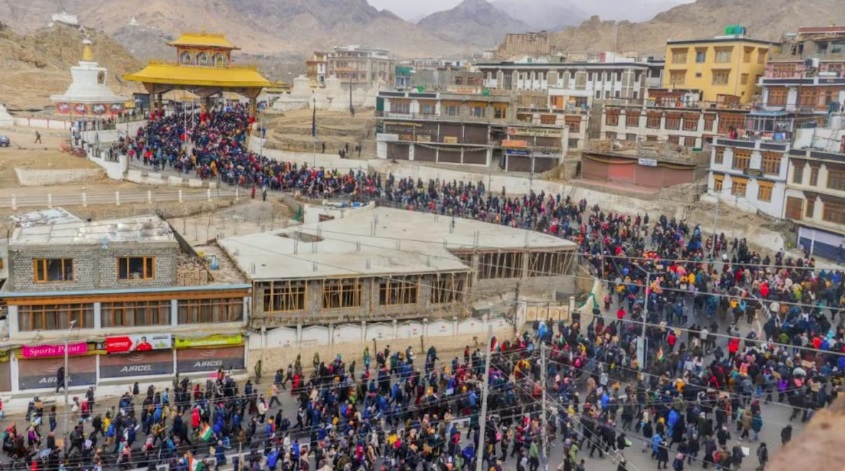Why Thousands of People Have Taken to the Streets in Ladakh- Ladakh, a region known for its breathtaking landscapes, is currently witnessing a surge in public demonstrations. Thousands of people have poured onto the streets, raising questions about the root causes of this unprecedented movement. In this article, we delve into the multifaceted reasons behind the protests and explore the various dimensions shaping this historic moment.
Why Thousands of People Have Taken to the Streets in Ladakh

The serene landscapes of Ladakh have become a backdrop to a growing wave of public dissent. The streets are alive with the voices of thousands, each echoing a unique concern. To understand the magnitude of this movement, we must first unravel the threads that have woven this intricate tapestry of protests.
Historical Context
Ladakh’s history is rich and complex, with socio-political currents that have shaped its destiny. Examining the historical events leading up to the present unrest provides a crucial backdrop to understanding the grievances fueling the protests.
Root Causes of Unrest
Several factors contribute to the current state of unrest in Ladakh. Economic disparities, environmental concerns, and the preservation of cultural identity are among the key issues that have galvanized the population.
Local Governance Issues
The local governance structures play a pivotal role in addressing or exacerbating the grievances of the people. Allegations of corruption and inefficiency have further fueled public frustration.
Impact on Daily Life
Beyond the slogans and banners, the protests have real consequences for the daily lives of Ladakh’s residents. Disruptions and economic consequences underscore the seriousness of the issues at hand.
Government Response
The government’s response to the protests is a critical aspect of the unfolding narrative. Analyzing official statements and actions provides insight into the dynamics between the state and its citizens.
International Perspectives
Ladakh’s unrest has not gone unnoticed on the global stage. Neighboring countries and international communities weigh in on the situation, offering both support and skepticism.
Media Influence
Media coverage plays a significant role in shaping public perception. The article explores the impact of media, both traditional and social, on the course of the protest movement.
Civil Society Participation
Civil society organizations are actively involved in the protests, representing a diverse range of interests. Grassroots movements emerge as influential players in this unfolding drama.
Social Media’s Role
In the age of connectivity, social media has emerged as a powerful tool for organizing and amplifying voices. The article examines how online activism shapes the narrative.
Challenges Faced by Protesters
Protesters face numerous challenges, from police interventions to arrests. Understanding these obstacles provides a comprehensive view of the resilience and determination within the movement.
Future Implications
What lies ahead for Ladakh? The potential outcomes of continued protests and their long-term effects on the socio-political landscape are explored in this section.
International Diplomacy
Efforts by international bodies to mediate and the broader implications for global relations are discussed, shedding light on the interconnectedness of the issue.
Voices of the People
Amid the protest fervor, the voices of the people are crucial. This section incorporates interviews or quotes from protesters, presenting the diverse perspectives within the movement.
Conclusion
As we reach the culmination of this exploration, it is evident that Ladakh’s streets are not just filled with protesters but with a collective call for change. Summarizing the key points, this section encourages ongoing dialogue and peaceful resolution.
Frequently Asked Questions
- Q: Are the protests in Ladakh solely about economic disparities?
- A: No, the protests encompass a range of issues, including environmental concerns and cultural preservation.
- Q: How has social media impacted the protest movement?
- A: Social media has played a significant role in organizing and amplifying voices, and shaping the narrative of the protests.
- Q: What is the government’s stance on the protests in Ladakh?
- A: The government’s response is varied, with official statements and actions reflecting a complex relationship with the protesters.
- Q: How are civil society organizations contributing to the protests?
- A: Civil society organizations are actively involved, representing diverse interests and contributing to the depth of the movement.
- Q: What are the potential long-term effects of the protests on Ladakh’s socio-political landscape?
- A: The article explores potential outcomes and long-term effects, considering the evolving nature of the protest movement.
ALSO READ- SP Leader Swami Prasad Maurya Faces Opposition in Kaushambi: Black Flags, Shoes, and Ink Unleashed
